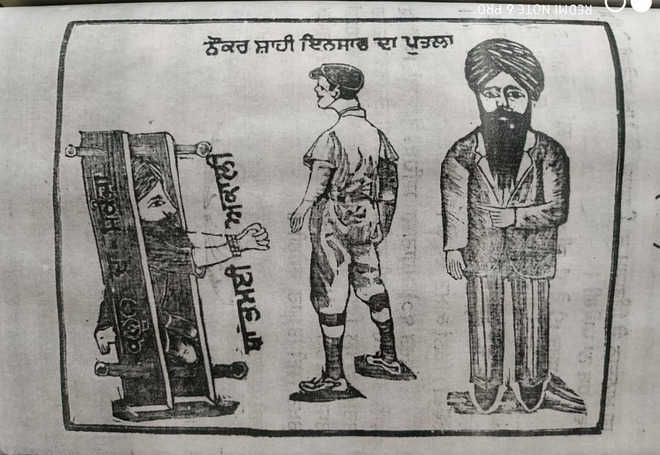Aparna Banerji
Tribune News Service
Jalandhar, April 12
Eh ajj rooh shaheedan de aakhde san, ‘Dyer’ kitiyan ethhe nalajjiyan san, etthe vaang kabootra tarafde san, Sannu es thaan goliyan vajjiyan san (the souls of martyrs say, Dyer committed monstrosities here, we writhed like pigeons, as we were shot here).
Lying with the British archives ever since they were banned in 1924-26, three Punjabi books detailing the pain of the Jallianwala Bagh massacre have been acquired by the Desh Bhagat Yadgaar Hall, penned to release the poetic angst after the heartless killing of thousands.
All written in Gurmukhi around 1924, the books include Ranjit Singh Taajwar’s ‘Khooni Kafan – Shahidi Pyala’ (a monologue depicting the pain of the Jallianwala Bagh massacre), Baghi Sikh Ki Sarkar? – Reading Shahi Insaaf Da Jhaka, penned by Rattan Singh Azad, and ‘Dukhan De Keerne’ by Feroz Din Sharaf.
The highlight of ‘Khooni Kafan’ is the depiction of the pain of Atar Kaur and Ratan Devi, who lost their husbands in the massacre.
In Khooni Kafan, Taajwar relates the tale of the massacre through his mouthpiece, the fictional character of ‘Ram Muhammed Singh’ (a name aimed at promoting Hindu-Muslim-Sikh harmony in those extremely divisive times). The introduction to the book states: “Pathak Jan... Sir tor koshish karke gair hukumat de hatthon bharat mata da chutkara karaun da yatan karan” (readers should read the book and make intense effort to free the motherland from alien rule).
The book talks about the courageous Atar Kaur. She was remembered as the valorous wife of Bhaag Mal Bhatia, who lost his life in the massacre on April 13, 1919. Having come to know that there had been a massacre at the bagh where her husband had gone to, a six-month pregnant Atar Kaur traversed through dead bodies on the ground through the entire afternoon and evening eventually finding him lying against a heavily damaged wall with his eyes open and breath gone.
Having offered Rs 5,000 by British officials five months after the massacre, Kaur refused by saying that she wouldn’t blacken her children’s faces by trading on the body of her martyred husband.
In its first poem “Reading Shahi Insaaf” in Baaghi Sikh Ki Sarkar? – a scathing critique on Lord reading’s policies, and support to Rpudaman Singh, Maharaja of Nabha, Azad writes: “Pichle vair badle tu naresh Nabha, ajj gaddi de utton utreya e, Reading Shahi Insaaf da badal parda, Sikh kaum te keher gujreya e (king of Nabha in return to atrocities you have stepped down from your throne, in your taking on Reading’s (in)justice, the Sikh community has received callousness). The book also has a cartoon, titled ‘Nakukar shahi insaaf da putla’ – which depicts a Sikh with tied hands bound in chains between two wooden panels labelled ‘Kanoon da shikanja’ as a British official stands over – a moving portrait of the shackles Sikhs felt at the time.
Historian Chiranji Lal Kangniwal, a member of the Desh Bhagat Yadgaar Committee, which has been working on acquiring many of these banned writings, says: “There is much pain and anger in poems of the martyrs. Many unsung heroes of the freedom struggle, including Atar Kaur and Ratan Devi, had sunk into oblivion. After ages we have acquired these books from the Britsh archives. For years since Independence, no one was allowed access to this treasure of patriotic writings. These deserve to be shared with the world.”
Unlock Exclusive Insights with The Tribune Premium
Take your experience further with Premium access.
Thought-provoking Opinions, Expert Analysis, In-depth Insights and other Member Only Benefits
Already a Member? Sign In Now











